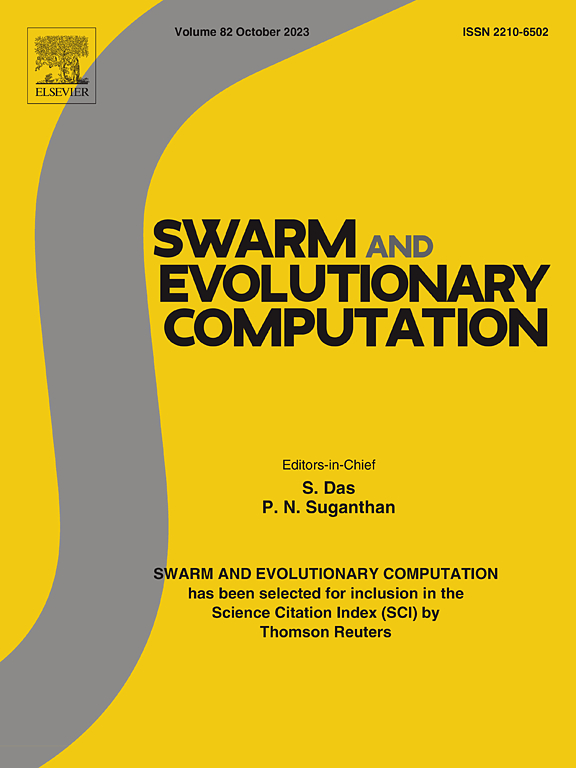Auxiliary optimization framework based on scaling transformation matrix for large-scale multi-objective problem
IF 8.5
1区 计算机科学
Q1 COMPUTER SCIENCE, ARTIFICIAL INTELLIGENCE
引用次数: 0
Abstract
Large-scale multi-objective optimization problems (LSMOPs) usually have a complex continuous search space, and it is difficult for a single optimization strategy to effectively explore the decision space. Meanwhile, the dimensionality reduction strategy is easy to lose the original data information and cannot be recovered in the optimization process. Therefore, this paper proposes an auxiliary optimization framework based on the scaling transformation matrix (AOF-STM) for solving the LSMOPs, which utilizes the optimization information from low-dimensional auxiliary problems to assist in the optimization of high-dimensional original problems. The construction of the scaling transformation matrix (STM) is based on calculating the similarity of the distribution features between the objective space and decision space, and then effective information sharing between different problems is achieved by STM. Specifically, each element STM () reflects the similarity between the -th decision variable (in low-dimensional auxiliary problem) and the -th decision variable (in high-dimensional original problem). Based on the proposed scaling transformation matrix STM, the information and experience of the low-dimensional auxiliary problem can be effectively used to guide the learning process of the original problem. Experimental results show that on LSMOPs with the 1000 to 50000 decision variables, AOF-STM shows better performance in terms of convergence and diversity than several state-of-the-art algorithms.
基于尺度变换矩阵的大规模多目标问题辅助优化框架
大规模多目标优化问题通常具有复杂的连续搜索空间,单一的优化策略难以有效地探索决策空间。同时,降维策略在优化过程中容易丢失原始数据信息,无法恢复。因此,本文提出了一种基于尺度变换矩阵(AOF-STM)的求解LSMOPs的辅助优化框架,利用低维辅助问题的优化信息来辅助高维原始问题的优化。尺度变换矩阵(STM)的构造是基于计算目标空间与决策空间之间分布特征的相似性,从而实现不同问题之间的有效信息共享。具体来说,每个元素STM (i,j)反映了第i个决策变量(在低维辅助问题中)和第j个决策变量(在高维原始问题中)之间的相似性。基于所提出的缩放变换矩阵STM,可以有效地利用低维辅助问题的信息和经验来指导原问题的学习过程。实验结果表明,在决策变量为1000 ~ 50000的LSMOPs上,AOF-STM在收敛性和多样性方面都优于几种最先进的算法。
本文章由计算机程序翻译,如有差异,请以英文原文为准。
求助全文
约1分钟内获得全文
求助全文
来源期刊

Swarm and Evolutionary Computation
COMPUTER SCIENCE, ARTIFICIAL INTELLIGENCEC-COMPUTER SCIENCE, THEORY & METHODS
CiteScore
16.00
自引率
12.00%
发文量
169
期刊介绍:
Swarm and Evolutionary Computation is a pioneering peer-reviewed journal focused on the latest research and advancements in nature-inspired intelligent computation using swarm and evolutionary algorithms. It covers theoretical, experimental, and practical aspects of these paradigms and their hybrids, promoting interdisciplinary research. The journal prioritizes the publication of high-quality, original articles that push the boundaries of evolutionary computation and swarm intelligence. Additionally, it welcomes survey papers on current topics and novel applications. Topics of interest include but are not limited to: Genetic Algorithms, and Genetic Programming, Evolution Strategies, and Evolutionary Programming, Differential Evolution, Artificial Immune Systems, Particle Swarms, Ant Colony, Bacterial Foraging, Artificial Bees, Fireflies Algorithm, Harmony Search, Artificial Life, Digital Organisms, Estimation of Distribution Algorithms, Stochastic Diffusion Search, Quantum Computing, Nano Computing, Membrane Computing, Human-centric Computing, Hybridization of Algorithms, Memetic Computing, Autonomic Computing, Self-organizing systems, Combinatorial, Discrete, Binary, Constrained, Multi-objective, Multi-modal, Dynamic, and Large-scale Optimization.
 求助内容:
求助内容: 应助结果提醒方式:
应助结果提醒方式:


